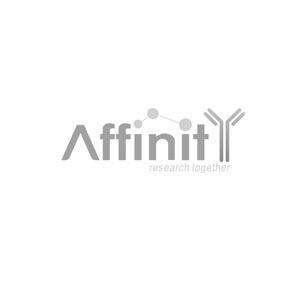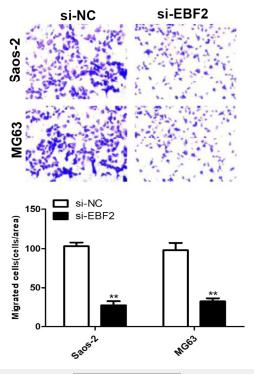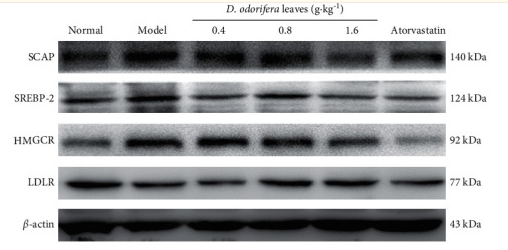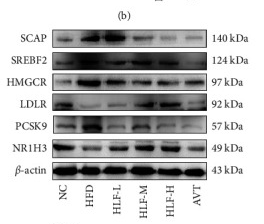SREBP2 Antibody - #DF7601
| Product: | SREBP2 Antibody |
| Catalog: | DF7601 |
| Description: | Rabbit polyclonal antibody to SREBP2 |
| Application: | WB IHC |
| Reactivity: | Human, Mouse, Rat |
| Prediction: | Pig, Zebrafish, Bovine, Horse, Sheep, Rabbit, Dog, Chicken, Xenopus |
| Mol.Wt.: | 124kDa; 124kD(Calculated). |
| Uniprot: | Q12772 |
| RRID: | AB_2841092 |
Related Downloads
Protocols
Product Info
*The optimal dilutions should be determined by the end user.
*Tips:
WB: For western blot detection of denatured protein samples. IHC: For immunohistochemical detection of paraffin sections (IHC-p) or frozen sections (IHC-f) of tissue samples. IF/ICC: For immunofluorescence detection of cell samples. ELISA(peptide): For ELISA detection of antigenic peptide.
Cite Format: Affinity Biosciences Cat# DF7601, RRID:AB_2841092.
Fold/Unfold
AI608257; bHLHd2; Class D basic helix-loop-helix protein 2; OTTHUMP00000028740; Processed sterol regulatory element-binding protein 2; SRBP2_HUMAN; SREBF 2; Srebf2; SREBF2 protein; SREBP 2; SREBP-2; SREBP2; SREBP2gc; sterol regulatory element binding factor 2; Sterol regulatory element binding protein 2; Sterol regulatory element binding transcription factor 2; Sterol regulatory element-binding transcription factor 2;
Immunogens
- Q12772 SRBP2_HUMAN:
- Protein BLAST With
- NCBI/
- ExPASy/
- Uniprot
MDDSGELGGLETMETLTELGDELTLGDIDEMLQFVSNQVGEFPDLFSEQLCSSFPGSGGSGSSSGSSGSSSSSSNGRGSSSGAVDPSVQRSFTQVTLPSFSPSAASPQAPTLQVKVSPTSVPTTPRATPILQPRPQPQPQPQTQLQQQTVMITPTFSTTPQTRIIQQPLIYQNAATSFQVLQPQVQSLVTSSQVQPVTIQQQVQTVQAQRVLTQTANGTLQTLAPATVQTVAAPQVQQVPVLVQPQIIKTDSLVLTTLKTDGSPVMAAVQNPALTALTTPIQTAALQVPTLVGSSGTILTTMPVMMGQEKVPIKQVPGGVKQLEPPKEGERRTTHNIIEKRYRSSINDKIIELKDLVMGTDAKMHKSGVLRKAIDYIKYLQQVNHKLRQENMVLKLANQKNKLLKGIDLGSLVDNEVDLKIEDFNQNVLLMSPPASDSGSQAGFSPYSIDSEPGSPLLDDAKVKDEPDSPPVALGMVDRSRILLCVLTFLCLSFNPLTSLLQWGGAHDSDQHPHSGSGRSVLSFESGSGGWFDWMMPTLLLWLVNGVIVLSVFVKLLVHGEPVIRPHSRSSVTFWRHRKQADLDLARGDFAAAAGNLQTCLAVLGRALPTSRLDLACSLSWNVIRYSLQKLRLVRWLLKKVFQCRRATPATEAGFEDEAKTSARDAALAYHRLHQLHITGKLPAGSACSDVHMALCAVNLAECAEEKIPPSTLVEIHLTAAMGLKTRCGGKLGFLASYFLSRAQSLCGPEHSAVPDSLRWLCHPLGQKFFMERSWSVKSAAKESLYCAQRNPADPIAQVHQAFCKNLLERAIESLVKPQAKKKAGDQEEESCEFSSALEYLKLLHSFVDSVGVMSPPLSRSSVLKSALGPDIICRWWTSAITVAISWLQGDDAAVRSHFTKVERIPKALEVTESPLVKAIFHACRAMHASLPGKADGQQSSFCHCERASGHLWSSLNVSGATSDPALNHVVQLLTCDLLLSLRTALWQKQASASQAVGETYHASGAELAGFQRDLGSLRRLAHSFRPAYRKVFLHEATVRLMAGASPTRTHQLLEHSLRRRTTQSTKHGEVDAWPGQRERATAILLACRHLPLSFLSSPGQRAVLLAEAARTLEKVGDRRSCNDCQQMIVKLGGGTAIAAS
Predictions
Score>80(red) has high confidence and is suggested to be used for WB detection. *The prediction model is mainly based on the alignment of immunogen sequences, the results are for reference only, not as the basis of quality assurance.
High(score>80) Medium(80>score>50) Low(score<50) No confidence
PTMs - Q12772 As Substrate
| Site | PTM Type | Enzyme | Source |
|---|---|---|---|
| S79 | Phosphorylation | Uniprot | |
| S80 | Phosphorylation | Uniprot | |
| S81 | Phosphorylation | Uniprot | |
| S101 | Phosphorylation | Uniprot | |
| S106 | Phosphorylation | Uniprot | |
| K115 | Ubiquitination | Uniprot | |
| S117 | Phosphorylation | Uniprot | |
| S120 | Phosphorylation | Uniprot | |
| T124 | Phosphorylation | Uniprot | |
| T153 | Phosphorylation | Uniprot | |
| T155 | Phosphorylation | Uniprot | |
| Y171 | Phosphorylation | Uniprot | |
| K249 | Sumoylation | Uniprot | |
| S252 | Phosphorylation | Uniprot | |
| K314 | Ubiquitination | Uniprot | |
| K321 | Acetylation | Uniprot | |
| K340 | Ubiquitination | Uniprot | |
| K349 | Ubiquitination | Uniprot | |
| K354 | Ubiquitination | Uniprot | |
| K363 | Acetylation | Uniprot | |
| K363 | Ubiquitination | Uniprot | |
| K366 | Ubiquitination | Uniprot | |
| K372 | Ubiquitination | Uniprot | |
| K378 | Ubiquitination | Uniprot | |
| K386 | Ubiquitination | Uniprot | |
| K395 | Ubiquitination | Uniprot | |
| K400 | Ubiquitination | Uniprot | |
| K405 | Ubiquitination | Uniprot | |
| K420 | Sumoylation | Uniprot | |
| S432 | Phosphorylation | P27361 (MAPK3) , P28482 (MAPK1) | Uniprot |
| S455 | Phosphorylation | P27361 (MAPK3) , P28482 (MAPK1) | Uniprot |
| K464 | Sumoylation | Uniprot | |
| K464 | Ubiquitination | Uniprot | |
| S469 | Phosphorylation | Uniprot | |
| K579 | Ubiquitination | Uniprot | |
| K630 | Acetylation | Uniprot | |
| K640 | Ubiquitination | Uniprot | |
| K660 | Ubiquitination | Uniprot | |
| K731 | Ubiquitination | Uniprot | |
| S745 | Phosphorylation | Uniprot | |
| K768 | Ubiquitination | Uniprot | |
| K778 | Ubiquitination | Uniprot | |
| K782 | Ubiquitination | Uniprot | |
| K805 | Ubiquitination | Uniprot | |
| K817 | Ubiquitination | Uniprot | |
| K821 | Ubiquitination | Uniprot | |
| K823 | Ubiquitination | Uniprot | |
| Y840 | Phosphorylation | Uniprot | |
| S855 | Phosphorylation | Uniprot | |
| K865 | Ubiquitination | Uniprot | |
| K901 | Ubiquitination | Uniprot | |
| K907 | Ubiquitination | Uniprot | |
| K918 | Ubiquitination | Uniprot | |
| K934 | Ubiquitination | Uniprot | |
| K989 | Ubiquitination | Uniprot | |
| K1031 | Ubiquitination | Uniprot | |
| S1046 | Phosphorylation | Uniprot | |
| S1057 | Phosphorylation | Uniprot | |
| K1067 | Ubiquitination | Uniprot | |
| S1094 | Phosphorylation | Uniprot | |
| S1098 | Phosphorylation | Uniprot | |
| K1115 | Ubiquitination | Uniprot | |
| S1121 | Phosphorylation | Uniprot |
Research Backgrounds
Transcriptional activator required for lipid homeostasis. Regulates transcription of the LDL receptor gene as well as the cholesterol and to a lesser degree the fatty acid synthesis pathway (By similarity). Binds the sterol regulatory element 1 (SRE-1) (5'-ATCACCCCAC-3') found in the flanking region of the LDRL and HMG-CoA synthase genes.
At low cholesterol the SCAP/SREBP complex is recruited into COPII vesicles for export from the ER. In the Golgi complex SREBPs are cleaved sequentially by site-1 and site-2 protease. The first cleavage by site-1 protease occurs within the luminal loop, the second cleavage by site-2 protease occurs within the first transmembrane domain and releases the transcription factor from the Golgi membrane. Apoptosis triggers cleavage by the cysteine proteases caspase-3 and caspase-7.
Phosphorylated by AMPK, leading to suppress protein processing and nuclear translocation, and repress target gene expression.
Endoplasmic reticulum membrane>Multi-pass membrane protein. Golgi apparatus membrane>Multi-pass membrane protein. Cytoplasmic vesicle>COPII-coated vesicle membrane>Multi-pass membrane protein.
Note: Moves from the endoplasmic reticulum to the Golgi in the absence of sterols.
Nucleus.
Ubiquitously expressed in adult and fetal tissues.
Forms a tight complex with SCAP in the ER membrane. Efficient DNA binding of the soluble transcription factor fragment requires dimerization with another bHLH protein. Interacts with LMNA. Component of SCAP/SREBP complex composed of SREBF2, SCAP and RNF139; the complex hampers the interaction between SCAP and SEC24B, thereby reducing SREBF2 proteolytic processing. Interacts (via C-terminal domain) with RNF139.
Belongs to the SREBP family.
References
Application: WB Species: rat Sample: BRL-3A hepatocytes
Application: WB Species: human Sample: MG63 cells
Application: IHC Species: human Sample: Migrated Saos-2 and MG63 cells
Application: WB Species: Rat Sample: liver
Application: WB Species: Rat Sample:
Restrictive clause
Affinity Biosciences tests all products strictly. Citations are provided as a resource for additional applications that have not been validated by Affinity Biosciences. Please choose the appropriate format for each application and consult Materials and Methods sections for additional details about the use of any product in these publications.
For Research Use Only.
Not for use in diagnostic or therapeutic procedures. Not for resale. Not for distribution without written consent. Affinity Biosciences will not be held responsible for patent infringement or other violations that may occur with the use of our products. Affinity Biosciences, Affinity Biosciences Logo and all other trademarks are the property of Affinity Biosciences LTD.





